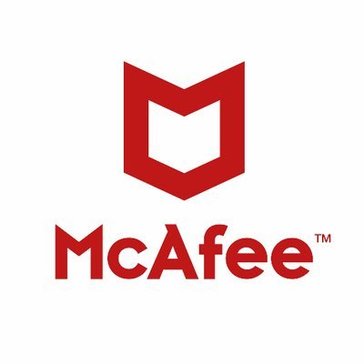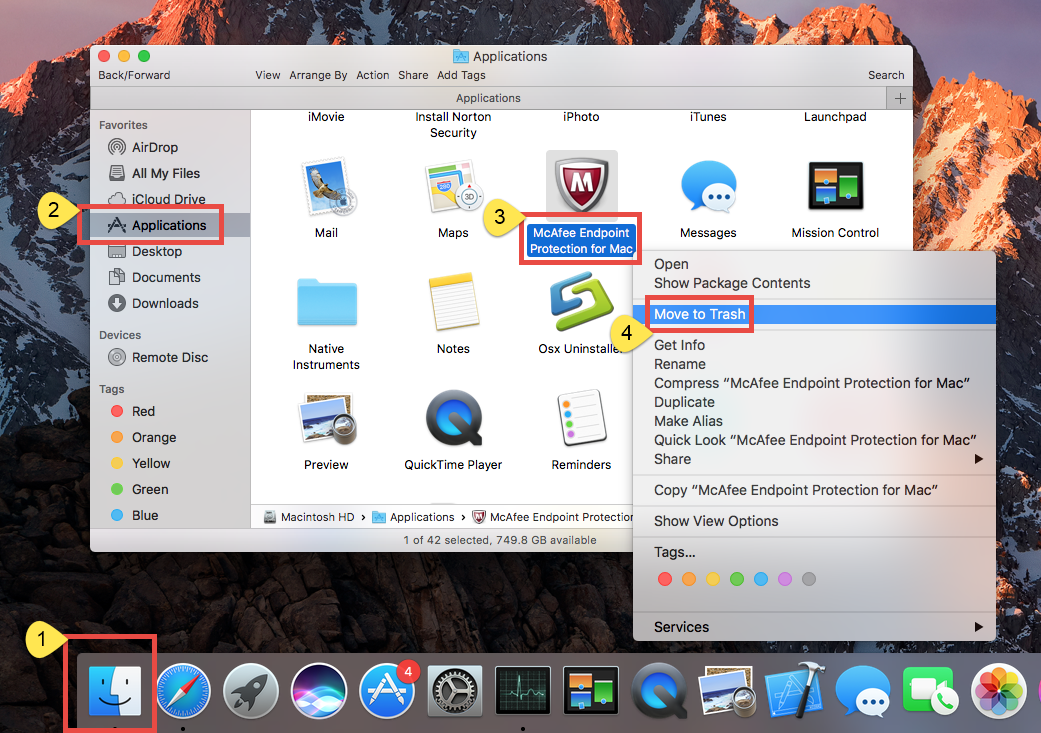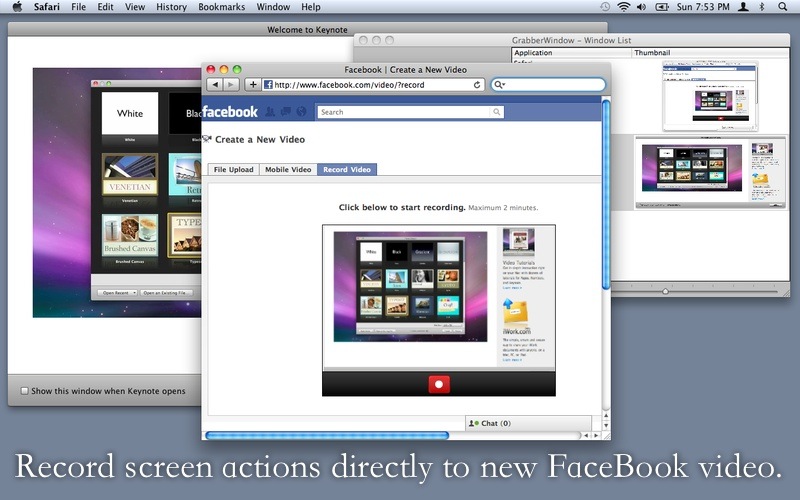Uninstall options include:. (including remote uninstalling of large groups).: Cleanwipe, manual removal methods. Here are the recommended methods for uninstalling the Symantec Endpoint Protection client. Uninstall for a small group of clients For small numbers of clients, use the.
Why you need security for Mac How McAfee Endpoint Protection for Mac protects your system Product features Why you need security for Mac Systems without protection might result in a security breach such as data loss, misuse of personal and business information, and system disorder. The McAfee VirusScan 9.7/Endpoint Protection for Mac On-access Scan setting is enabled and scanning takes place every time you create or access an item, like a file or folder. When a virus is found, the primary action is Clean.
Uninstall for a large group of clients When accessing each client physically is not practical, there are many ways to automate the process. These include:.
(12.1.x only) It is possible to remove specific components from a Symantec Endpoint Protection client without the need to fully uninstall and reinstall. Removing components from a client You can modify the installation for managed or unmanaged clients using Add or Remove Programs, or Programs and Features. You can find more information by visiting. Removing components from multiple clients You can use the Symantec Endpoint Protection Manager (enterprise edition only) to modify the installation features on an entire group.
Instructions for doing this can also be found in. Uninstall and reinstall LiveUpdate To uninstall and reinstall LiveUpdate without uninstalling the Symantec Endpoint Protection Manager, see. The Symantec Endpoint Protection Manager uninstall is fairly straightforward and should be done on a per-manager basis. The following table lists topics that are related to this process. Backing up the Symantec Endpoint Protection Manager You should back up the Symantec Endpoint Protection Manager using disaster recovery procedures.
If you need to uninstall the Symantec Endpoint Protection Manager, making these preparations in advance makes it easier to reconnect with existing clients and use previously configured policies when you reinstall. For information on preparing for disaster recovery, see Removing the Symantec Endpoint Protection Manager The recommended method is to use the standard Windows uninstall method. For more information, see. Connecting existing clients to a new or reinstalled Symantec Endpoint Protection Manager If it becomes necessary to uninstall and reinstall the Symantec Endpoint Protection Manager without preparing in advance for disaster recovery, it is possible to reconnect existing Symantec Endpoint Protection clients to a new manager installation. See the following document for more information:.
McAfee Endpoint Protection is the latest security suite developed by McAfee for Mac computers. As a paid software, it helps protect Mac users against viruses, spyware, Trojan horses, and other malware threats.
Sometimes the recommended and preferred methods for uninstalling Symantec Endpoint Protection fail or do not work as expected. Cleanwipe The Cleanwipe utility is intended for use only when uninstalling Symantec Endpoint Protection from the Windows control panel fails. For this utility, see. Manual Removal You can perform a manual removal. Instructions for the manual removal of Symantec Endpoint Protection 12.1 and legacy products Symantec Endpoint Protection 12.0 Small Business and Symantec Endpoint Protection 11.x can be found in the knowledge base article. Removing the Symantec Endpoint Protection client from Mac computers requires different methods and tools. Removal from a single client or small group of clients As of version 14, you can uninstall directly on the Mac.
As of 14.0.1, open the client user interface, then click Symantec Endpoint Protection Uninstall Symantec Endpoint Protection. You may be required to enter a password. In versions earlier than 14.0.1 (14 RU1), click the Symantec Endpoint Protection client icon in the Menu bar, then click Uninstall.
For 12.1.x, Use the Symantec Uninstaller. For detailed instructions and how to get the tool, see. Removal from a large group of clients You can accomplish removing a large number of clients at once by using the SymantecRemovalTool in conjunction with a remote management system like Apple Remote Desktop. You can find more information about SymantecRemovalTool by visiting the appropriate section in. What to do if conventional methods fail The RemoveSymantecMacFiles utility will remove all files and folders related to the Mac client install.
More information and instructions for use can be found in the document. NOTE that RemoveSymantecMacFiles/SymantecRemovalTool will remove ALL Symantec products from a Mac. See attachments section of this document for SEP-only removal tool for Mac, 'SEPUninstaller'.
IMPORTANT: Before upgrading to Mac OS X 10.10 Yosemite, we recommend installing McAfee VirusScan 9.7/Endpoint Protection for Mac. Earlier versions will not work correctly under Mac OS X 10.10 Yosemite. If you have an earlier version of McAfee VirusScan for Mac installed on your computer, it will be overwritten while installing McAfee VirusScan 9.7/Endpoint Protection for Mac. System Requirements. Operating System with the latest Sofware Update:. Mac OS X 10.10 Yosemite.
Mac OS X 10.9 Mavericks. Mac OS X 10.8 Mountain Lion.
Mac OS X 10.7 Lion. Mac OS X server 10.10 / 10.9 / 10.8 / 10.7 Installation instructions for McAfee VirusScan 9.7/Endpoint Protection for Mac:. For OS X 10.10 Users Install McAfee VirusScan 9.7/Endpoint Protection for Mac onto a system with Mac OS X 10.10 as follows:.

Download McAfee VirusScan installer files. Log into an administrative account. Verify you have a working Internet connection. If you are running other applications, save your data and close them. Click on to download the installation package.
Enter your SF State ID and Password then click Login. Click on the Yes or No radio button in response to the prompt, Will this be installed on a state owned computer? Click on the Submit button.
Click on the VSM970-RTW-1298.dmg link to download the file to your computer. Firefox: Select Save File then click OK to download the file. Safari: The file will download immediately. Click on to download the compressed file version (.zip extension) of the folder. Enter your SF State ID and Password then click Login.
Click on the Yes or No radio button in response to the prompt, Will this be installed on a state owned computer? Click on the Submit button. Click on the MA480P2HF972377.zip link to download the file to your computer. Firefox: Select Save File then click OK to download the file. Safari: The file will download and a folder named MA480P2HF972377 that includes the installation software will be created.
Install McAfee VirusScan 9.7/Endpoint Protection for Mac. Double-click on the disk image file VSM970-RTW-1298.dmg to display VSM970-RTW-1298.pkg. Double-click on the file VSM970-RTW-1298.pkg.
Proper Ways To Remove Mcafee Endpoint Protection For Mac Pro

Click Continue to determine if the software can be installed. Click Continue in the Installer Introduction window. Click Continue after reviewing What’s New. Click Continue after reading the End User License Agreement. Click Agree to accept the Software License Agreement. Click Install to continue.
Type the Administrator account password and click Install Software. When the install is done, the message, The Installation was successful is displayed.
Uninstall the currently installed McAfee Agent:. Open a Finder window. Click on the Go menu and select Utilities. Double-click on the Terminal icon.
You will see the command prompt which includes the User ID for the account you are in and the '$' character (e.g., jdoe$). Type, sudo /Library/McAfee/cma/uninstall.sh (there is a space after “sudo”). Press the Return key. A Warning about improper use of the sudo command will be displayed, then a prompt to enter the account password. Enter the Administrator account password and press the Return key. Note: Nothing will be displayed in the terminal window as you enter your password and you cannot backspace. Information on the process to uninstall the McAfee Agent will be displayed.
When completed, the command prompt will be displayed. If the Mac account does not have administrative rights, you will see: account name is not in the sudoers file.
This incident will be reported. Then quit the Terminal application, logout of that account and log into an account with administrative rights. If the Agent has already been uninstalled, you will see: sudo: /library/McAfee/cma/uninstall.sh: command not found. Continue to the next step. Type exit then press the Return key.
Click on the Terminal menu and select Quit Terminal. Install McAfee Agent 4.8 for Mac Patch 2 HF972377. If you used Firefox to download the Agent 4.8 Patch 2 installer, double-click on MA480P2HF972377.zip to create the MA480P2HF972377 folder. Open the MA480P2HF972377 folder and Control-click (or right-click) on the file setup, then select Open to install. Select Open in the next popup window.
When the process begins, a Terminal application window will open and you will see information displayed. Wait until the message Process completed is displayed. This can take up to two minutes.
Click on the Terminal menu and select Quit Terminal. For OS X 10.10 Users who installed McAfee VirusScan 9.7 before upgrading to OS X 10.10 These instructions are for Mac OS X 10.10 users who already installed McAfee VirusScan 9.7/Endpoint Protection for Mac but do not have the correct version of the component, McAfee Agent 4.8 for Mac Patch 2 HF972377.

Download McAfee Agent 4.8 for Mac Patch 2 HF972377 installer file. Log into an administrative account. Verify you have a working Internet connection. If you are running any applications, save your data and close them. Click on to download the compressed file version (.zip extension) of the folder. Enter your SF State ID and Password then click Login.
Click on the Yes or No radio button in response to the prompt, Will this be installed on a state owned computer? Click on the Submit button. Click on the MA480P2HF972377.zip link to download the file to your computer.
Firefox: Select Save File then click OK to download the file. Safari: The file will download and a folder named MA480P2HF972377 that includes the installation software will be created. Uninstall the currently installed McAfee Agent:. Open a Finder window.
Click on the Go menu and select Utilities. Double-click on the Terminal icon. You will see the command prompt which includes the User ID for the account you are in and the '$' character.
Type, sudo /Library/McAfee/cma/uninstall.sh (there is a space after “sudo”). Press the Return key.
A Warning about improper use of the sudo command will be displayed, then a prompt to enter the account password. Enter the Administrator account password and press the Return key. Note: Nothing will be displayed in the terminal window as you enter your password and you cannot backspace.
Information on the process to uninstall the McAfee Agent will be displayed. When completed, the command prompt will be displayed. If the Mac account does not have administrative rights, you will see: account name is not in the sudoers file. This incident will be reported. Then quit the Terminal application, logout of that account and log into an account with administrative rights.
If the Agent has already been uninstalled, you will see: sudo: /library/McAfee/cma/uninstall.sh: command not found. Continue to the next step. Type exit then press the Return key. Click on the Terminal menu and select Quit Terminal. Install McAfee Agent 4.8 for Mac Patch 2 HF972377.
If you used Firefox to download the Agent 4.8 Patch 2 installer, double-click on MA480P2HF972377.zip to create the MA480P2HF972377 folder. Open the MA480P2HF972377 folder and Control-click (or right-click) on the file setup, then select Open to install.
Select Open in the next popup window. When the process begins, a Terminal application window will open and you will see information displayed.
Wait until the message Process completed is displayed. This can take up to two minutes. Click on the Terminal menu and select Quit Terminal. For OS X 10.7 – OS X 10.9 Users Install McAfee VirusScan 9.7/Endpoint Protection for Mac onto a computer with Mac OS X 10.9 or earlier as follows:. Download McAfee VirusScan installer files.
Log into an administrative account. Verify you have a working Internet connection. If you are running other applications, save your data and close them. Click on to download the installation package. Enter your SF State ID and Password then click Login. Click on the Yes or No radio button in response to the prompt, Will this be installed on a state owned computer? Click on the Submit button.
Click on the VSM970-RTW-1298.dmg link to download the file to your computer. Firefox: Select Save File then click OK to download the file. Safari: The file will download immediately. Click on to download the compressed file version (.zip extension) of the folder.
Enter your SF State ID and Password then click Login. Click on the Yes or No radio button in response to the prompt, Will this be installed on a state owned computer? Click on the Submit button.
Click on the MA480P2HF972377.zip link to download the file to your computer. Firefox: Select Save File then click OK to download the file.
Safari: The file will download and a folder named MA480P2HF972377 that includes the installation software will be created. Install McAfee VirusScan 9.7/Endpoint Protection for Mac. Double-click on the disk image file VSM970-RTW-1298.dmg to display VSM970-RTW-1298.pkg. Double-click on the file VSM970-RTW-1298.pkg. Click Continue to determine if the software can be installed. Click Continue in the Installer Introduction window.
Click Continue after reviewing What’s New. Click Continue after reading the End User License Agreement. Click Agree to accept the Software License Agreement. Click Install to continue.
Type the Administrator account password and click Install Software. When the install is done, the message, The Installation was successful is displayed. Install McAfee Agent 4.8 for Mac Patch 2 HF972377. If you used Firefox to download the Agent 4.8 Patch 2 installer, double-click on MA480P2HF972377.zip to create the MA480P2HF972377 folder.
Open the MA480P2HF972377 folder and Control-click (or right-click) on the file setup, then select Open to install. Select Open in the next popup window.
When the process begins, a Terminal application window will open and you will see information displayed. Wait until the message Process completed is displayed. This can take up to two minutes. Click on the Terminal menu and select Quit Terminal. Updating the Virus Definition (DAT) File Every day new viruses appear, so ensure that your computer is always protected by keeping the anti-virus software up to date. McAfee regularly updates a virus definition ( DAT) file and makes it available on the McAfee Website for users to download to combat new virus threats as they emerge. Each DAT file brings new detection and cleaning capabilities to McAfee VirusScan 9.7/Endpoint Protection for Mac.
The program is set up to check for DAT updates every day. If an update is available, it will be downloaded and installed automatically. Scanning Your Computer for Viruses The McAfee VirusScan 9.7/Endpoint Protection for Mac On-access Scan setting is enabled and scanning takes place every time you create or access an item, like a file or folder.
When a virus is found, the primary action is Clean. If that action fails then the item is Quarantined. On-demand Scanning is also available. Manually scan items of your choice, including archives, compressed files, Apple Mail messages and network volumns. To perform an on-demand scan, follow the steps below:.
Locate the McAfee VirusScan 9.7/Endpoint Protection for Mac application icon in the Applications folder and double-click it. Click Scan Now under ACTIVITY in the left-hand column.
Select the item to be scanned by using the drop-down list under the What to scan section. The default location is the current account's Home directory. Alternatively, you can drag and drop the item to be scanned in this section of the window. Click the Start Scan button to begin the scan.
When the scan is completed, a summary will be displayed with the number of threats detected and the number of items scanned. Click on the McAfee Endpoint Protection for Mac menu and select Quit.
